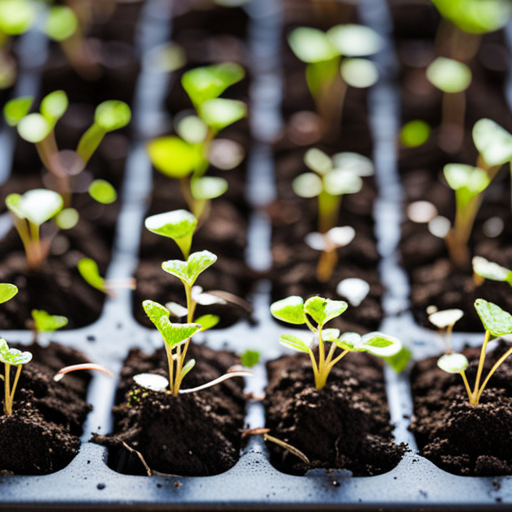
Starting okra seeds indoors can give your garden a head start, especially in cooler climates where the growing season is shorter. Okra (Abelmoschus esculentus) thrives in warm temperatures and needs plenty of sunlight to grow strong and healthy. By planting seeds indoors, you can ensure your plants are ready to go into the garden as soon as the weather warms up. Here’s a step-by-step guide to starting okra seeds indoors, including the best seed varieties, planting timelines, and care tips.
Types of Okra Seeds to Start Indoors
There are several okra varieties that you can start indoors, depending on your taste preferences and gardening goals. Popular options include:
- Clemson Spineless – Known for its smooth, tender pods, this variety matures in about 55-60 days.
- Burgundy Okra – Featuring deep red pods, it adds a colorful touch to your garden and is ready in 55 days.
- Emerald Okra – Produces long, slender green pods and takes about 58 days to mature.
- Jing Orange Okra – A unique variety with orange pods, ideal for warm climates, and matures in 60 days.
- Cajun Delight – Fast-growing and heat-tolerant, this type is ready for harvest in just 50 days.
- Baby Bubba Hybrid – Compact and perfect for small spaces or containers, it matures in 53 days.
When to Start Okra Seeds Indoors
Timing depends on your USDA hardiness zone:
- Zone 3-5: Start seeds indoors 6-8 weeks before the last expected frost, usually in early March.
- Zone 6-7: Begin planting 4-6 weeks before the last frost date, typically in mid-to-late March.
- Zone 8-10: Start seeds indoors 3-4 weeks before the last frost, around late February or early March.
Count backward from your area’s last frost date to determine the ideal planting time.
How to Start Okra Seeds Indoors
- Prepare Seed Trays: Use seed-starting trays with individual cells or biodegradable pots to give each seed enough space to grow. Ensure the trays have drainage holes.
- Choose the Right Soil: Use a light, well-draining seed-starting mix. Avoid heavy garden soil, which can compact and restrict root growth.
- Soak the Seeds: Okra seeds have a hard outer shell. Soak them in warm water for 12-24 hours before planting to speed up germination.
- Plant the Seeds: Sow one seed per cell, about 1/2 inch deep. Cover lightly with soil and gently water until moist but not soggy.
- Add Heat: Place the seed trays on a heat mat set to 70-80°F to encourage germination. Okra seeds need warmth to sprout, so maintaining consistent heat is crucial. While a heat mat is not necessary it will speed up the germination process.
- Cover the Trays: Use a humidity dome or plastic wrap to trap moisture and warmth, creating a greenhouse effect.
Caring for Seedlings Under Grow Lights
- Provide Light: As soon as the seeds sprout, place them under grow lights for 12-16 hours daily. Position the lights about 2-3 inches above the seedlings to prevent stretching.
- Water Regularly: Keep the soil consistently moist but avoid overwatering. Let the top layer dry slightly between waterings.
- Fertilize Lightly: Once seedlings develop their first set of true leaves, feed them with a half-strength liquid fertilizer every two weeks. Choose a balanced fertilizer, such as 10-10-10.
- Thin Out Seedlings: If multiple seeds sprout in the same cell, thin them to one healthy seedling by snipping the weaker ones at soil level.
How Long to Keep Seedlings Indoors
Keep okra seedlings indoors for 4-6 weeks or until they are about 4-6 inches tall with several sets of leaves. At this stage, they will be strong enough to handle the transition outdoors.
How to Harden Off Okra Seedlings
Hardening off prepares indoor seedlings for outdoor conditions. Start this process about 7-10 days before planting outside.
- Move Outdoors Gradually: Begin by placing seedlings outside in a shaded, sheltered spot for 1-2 hours. Gradually increase the time outdoors by 1-2 hours each day.
- Expose to Sunlight: After a few days, introduce the seedlings to direct sunlight for short periods, increasing exposure daily.
- Protect from Wind and Cold: Bring seedlings indoors at night if temperatures drop below 55°F. Continue hardening off until the seedlings can handle full outdoor conditions.
When to Plant Okra Outdoors
Plant okra outdoors when nighttime temperatures consistently stay above 60°F and the soil has warmed to at least 65°F. For most regions, this happens 2-3 weeks after the last frost date. Space plants 12-18 inches apart in rows, leaving 3 feet between rows for easy access and airflow.
Final Tips for Healthy Okra Plants
- Water Needs: Okra prefers moist, well-drained soil. Water deeply once or twice a week, especially during dry spells.
- Mulch: Add mulch around the base of the plants to retain moisture and suppress weeds.
- Fertilize: Use a balanced fertilizer every 3-4 weeks to support growth and pod production.
- Watch for Pests: Keep an eye out for aphids, flea beetles, and stink bugs. Use insecticidal soap if necessary.
Conclusion
Starting okra seeds indoors is a rewarding way to ensure your plants get a strong start before moving outdoors. Choose the right variety, follow the recommended planting schedule for your zone, and provide proper care during germination and growth. With adequate hardening off and timely transplanting, your okra plants will thrive and produce abundant harvests throughout the summer. Whether you prefer traditional green pods or colorful varieties, growing okra from seed allows you to enjoy fresh produce straight from your garden.
Please be sure to check out my Gardening Blog Post Page for more tips on all types of gardening. Including Seed Saving, Seed Starting, Orchids, Water Gardening, Coldframe Gardening, Indoor Bulb Gardening, Hydroponics, Container Gardening, Mums, Herbs, African Violets, planting Bulbs, Flower Gardening, Vegetable and Fruit Gardening, Indoor Houseplants of all kinds, Cactus, Succulents, Hanging plants, Deer resistant plants and even Bird, Bee, Butterfly and Hummingbird Gardens!
